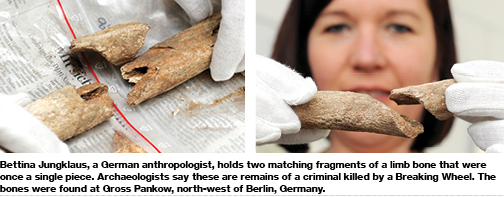

Death was almost always a relief for people sentenced to be publicly executed on a medieval instrument of torture known as the ‘Breaking Wheel’. The person first had the main bones in his body broken, before being lashed to a cartwheel and left to die in agony - a decline that could take three or four days. The remains were left for carrion-eating birds to feast on. Archeologists have discovered the skeleton of a man executed by the Wheel at a site halfway between Berlin and Hamburg. “It is a unique discovery,” says Jost Auler, archeologist and author of several books about executions. For the first time scientists can examine first-hand the damage caused by this brutal punishment. Victims of the Wheel were, in some cases, left to rot in public for years, as a warning to others. “Birds usually took the bones away,” says Auler. “The Breaking Wheel is a striking and frightening part of our culture and legal history,” explains Franz Schopper, Director of the Brandenburg State Archeological Heritage Service, which oversaw the dig. Modern Germany has outlawed the death penalty and objects to its use by the United States and other nations.
“It started off as a normal excavation day,” says archeologist Elisabeth Kirsch, recounting the day in the autumn of 2013 when the skeleton was unexpectedly unearthed while clearing space for a highway. First, a couple of vessel fragments were uncovered, followed by a stone axe and clay brick fragments. None of this was spectacular, coming from a late Bronze Age settlement (1st century BC). The scenario changed when much newer-looking bone fragments were revealed. “The appearance was shocking and could not be explained by normal anatomical rules,” says anthropologist Bettina Jungklaus, who was immediately called to look at the discovery. The dead person had been positioned on his back with his arms stretched back, the forearms towards his neck. His legs were turned completely behind him. Every long bone had been smashed - many of them had multiple fractures. The body was ‘dated’ between the 15th and 17th century, thanks also to an iron buckle found at the site. Execution on the Breaking Wheel was a horrific experience carried out in two steps. “The executioner first used the Wheel rim to smash the main bones of the naked, condemned man,” explains Wolfgang Schild, an expert in the legal history of the Middle Ages. “The objective of this was not to kill the delinquent. He was meant to die later, while on the Wheel.” The broken body was then either tied to the Wheel, or even woven in and out of its spokes. The Wheel was then mounted on a pole and the criminal was left to endure a slow painful death from his injuries. Even a photograph of the mangled body - estimated to be a man between the ages of 35 of 39 - is shocking to view, and provides an insight to the suffering endured by the victims of these medieval and early modern executioners. The discovery of about 1,000 bone fragments means that, for the first time, scientists can document the exact torture suffered by men who were condemned to death on the Breaking Wheel. One particularly heavy blow, for example, tore away half the victim’s face, as evidenced by the frayed skull. It remains unclear as to what crime this person had committed, to warrant such a draconian punishment, as there are no surviving records of these executions. Until it ceased being used in the 18th century, the ‘Wheel’ was the punishment reserved primarily for men convicted of heinous murders, says local legal scholar Stefan Saar. It is possible that the person in Gross Pankow met his end at the Wheel and was subsequently buried by a merciful local.
Read More...